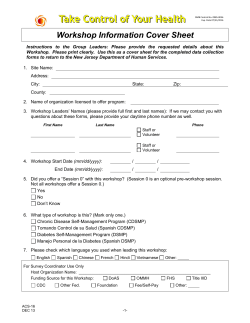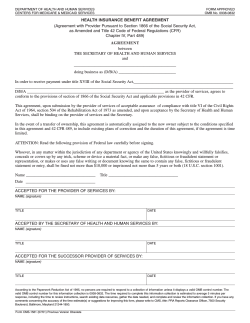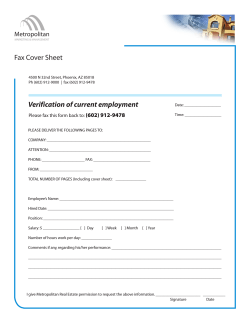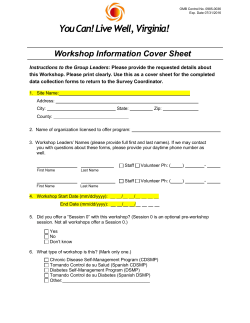
65765 Federal Register T 1—P
65765 Federal Register / Vol. 79, No. 214 / Wednesday, November 5, 2014 / Notices TABLE 1—PUBLIC TRANSPORTATION RESILIENCE PROJECTS IN RESPONSE TO HURRICANE SANDY—Continued Project sponsor Project title Funding ID New York Metropolitan Transportation Authority (MTA). Hardening of Substations in Flood Prone Areas and Purchase of Mobile Substations (NYCT). Protection of Tunnel Portals and Internal Tunnel Sealing (NYCT). Flood Resiliency for Long Island City Yard (LIRR). Flood Resiliency for Critical Support Facilities (NYCT). Protection of Street Level Openings in Flood Prone Areas (NYCT). Metro-North Railroad Power and Signals Resiliency Improvements. Internal Station Hardening (NYCT) ................. D2013–RESL–018 ..... 112,050,000 D2013–RESL–019 ..... 43,090,000 D2013–RESL–020 ..... 19,150,000 D2013–RESL–021 ..... 24,320,000 D2013–RESL–022 ..... 300,690,000 D2013–RESL–023 ..... 37,500,000 D2013–RESL–024 ..... 19,730,000 Pumping Capacity Improvements (NYCT) ...... D2013–RESL–025 ..... 24,140,000 Right-of-Way (ROW) Equipment Hardening in Flood-Prone Areas (NYCT). New York-New Jersey River to River Rail Resiliency (R4) Project (LIRR). Rockaway Line Protections (NYCT) ............... D2013–RESL–026 ..... 63,550,000 D2013–RESL–027 ..... 81,007,104 D2013–RESL–028 ..... 136,820,000 D2013–RESL–029 ..... 44,770,000 D2013–RESL–032 ..... 9,003,000 D2013–RESL–033 ..... 18,739,000 D2013–RESL–034 ..... 3,752,000 D2013–RESL–035 ..... 32,026,000 D2013–RESL–036 ..... 14,987,000 D2013–RESL–037 ..... 4,502,000 D2013–RESL–038 ..... 3,749,000 D2013–RESL–039 ..... 13,500,000 D2013–RESL–040 ..... 7,500,000 New York Metropolitan Transportation Authority (MTA). New York Metropolitan Transportation Authority (MTA). New York Metropolitan Transportation Authority (MTA). New York Metropolitan Transportation Authority (MTA). New York Metropolitan Transportation Authority (MTA). New York Metropolitan Transportation Authority (MTA). New York Metropolitan Transportation Authority (MTA). New York Metropolitan Transportation Authority (MTA). New York Metropolitan Transportation Authority (MTA). New York Metropolitan Transportation Authority (MTA). New York Metropolitan Transportation Authority (MTA). Southeastern Pennsylvania Transportation Authority (SEPTA). Southeastern Pennsylvania Transportation Authority (SEPTA). Southeastern Pennsylvania Transportation Authority (SEPTA). Southeastern Pennsylvania Transportation Authority (SEPTA). Southeastern Pennsylvania Transportation Authority (SEPTA). Southeastern Pennsylvania Transportation Authority (SEPTA). Southeastern Pennsylvania Transportation Authority (SEPTA). Washington Metropolitan Area Transit Authority (WMATA). Washington Metropolitan Area Transit Authority (WMATA). Total ................................................................ [FR Doc. 2014–26244 Filed 11–4–14; 8:45 am] BILLING CODE P DEPARTMENT OF TRANSPORTATION National Highway Traffic Safety Administration [U.S. DOT Docket No. NHTSA–2014–0091] Reports, Forms, and Recordkeeping Requirements mstockstill on DSK4VPTVN1PROD with NOTICES Before a Federal agency can collect certain information from the public, it must receive approval from the Office of Management and Budget (OMB). Under procedures established SUMMARY: VerDate Sep<11>2014 17:42 Nov 04, 2014 Jkt 235001 SEPTA Railroad Embankment & Slope Stabilization Project. SEPTA Sharon Hill Line Flood Mitigation Project. SEPTA Railroad Signal Power Reinforcement Project. SEPTA Jenkintown Area Flood Mitigation Project. SEPTA Manayunk/Norristown Line Shoreline Stabilization Project. SEPTA Subway Pump Room Emergency Power Project. Protecting the Subway System by Raising Ventilation Shaft Elevations. Protecting WMATA’s Existing Subway System Investment by Improving Drainage. ..................................................................... by the Paperwork Reduction Act of 1995 (44 U.S.C. 3501 et seq.), before seeking OMB approval, Federal agencies must solicit public comment on proposed collections of information, including extensions and reinstatements of previously approved collections. This document describes an Information Collection Request (ICR) for which NHTSA intends to seek OMB approval. Comments must be submitted on or before January 5, 2015. ADDRESSES: You may submit comments identified by DOT Docket ID Number NHTSA–2014–0091 using any of the following methods: Electronic submissions: Go to http:// www.regulations.gov. Follow the online instructions for submitting comments. Mail: Docket Management Facility, M–30, U.S. Department of DATES: National Highway Traffic Safety Administration (NHTSA), DOT. ACTION: Request for public comment on proposed collection of information. AGENCY: Flood Resiliency for Critical Bus Depots (NYCT). SEPTA Ancillary Control Center Project ........ PO 00000 Frm 00151 Fmt 4703 Sfmt 4703 ................................ Amount 3,591,883,625 Transportation, 1200 New Jersey Avenue SE., West Building Ground Floor, Room W12–140, Washington, DC 20590. Hand Delivery: West Building Ground Floor, Room W12–140, 1200 New Jersey Avenue SE., Washington, DC, between 9 a.m. and 5 p.m., Monday through Friday, except Federal holidays. Fax: 1–202–493–2251. Instructions: Each submission must include the Agency name and the Docket number for this Notice. Note that all comments received will be posted without change to http:// www.regulations.gov including any personal information provided. FOR FURTHER INFORMATION CONTACT: Diane Wigle, Division Chief, Impaired Driving Division (NTI–111), Office of Impaired Driving and Occupant Protection, National Highway Traffic E:\FR\FM\05NON1.SGM 05NON1 mstockstill on DSK4VPTVN1PROD with NOTICES 65766 Federal Register / Vol. 79, No. 214 / Wednesday, November 5, 2014 / Notices Safety Administration, 1200 New Jersey Avenue SE., W44–301, Washington, DC 20590. Ms. Wigle’s phone number is 202–366–2695 and her email address is diane.wigle@dot.gov SUPPLEMENTARY INFORMATION: Under the Paperwork Reduction Act of 1995, before an agency submits a proposed collection of information to OMB for approval, it must publish a document in the Federal Register providing a 60-day comment period and otherwise consult with members of the public and affected agencies concerning each proposed collection of information. The OMB has promulgated regulations describing what must be included in such a document. Under OMB’s regulations (at 5 CFR 1320.8(d)), an agency must ask for public comment on the following: (i) Whether the proposed collection of information is necessary for the proper performance of the functions of the agency, including whether the information will have practical utility; (ii) The accuracy of the agency’s estimate of the burden of the proposed collection of information, including the validity of the methodology and assumptions used; (iii) How to enhance the quality, utility, and clarity of the information to be collected; and (iv) How to minimize the burden of the collection of information on those who are to respond, including the use of appropriate automated, electronic, mechanical, or other technological collection techniques or other forms of information technology, e.g., permitting electronic submission of responses. In compliance with these requirements, NHTSA asks public comment on the following proposed collection of information: Title—Special Study on 18–24 Year Old Drivers Involved in Alcohol-Related Motor Vehicle Crashes Type of Request—New information collection request OMB Clearance Number—None. Form Number—This collection of information uses no standard form Requested Expiration Date of Approval—3 years from date of approval. Summary of the Collection of Information—NHTSA has been particularly concerned with 18- to-24year-old drivers’ propensity for highrisk driving behaviors and overrepresentation in impaired driving crashes. While data collection efforts exist to identify basic demographics and some details of crash involvement, there is insufficient information to define the characteristics, circumstances, and patterns of 18-to-24-year-old drivers VerDate Sep<11>2014 17:42 Nov 04, 2014 Jkt 235001 involved in alcohol-related motor vehicle crashes. NHTSA needs this information to design programs that are most likely to affect this age group. NHTSA plans to collect and analyze information on: (1) Environmental or behavioral conditions that may have played a role in the cause of the crash, (2) whether there is a correlation between trip purpose, type, frequency, departure, destination, or familiarity of location, (3) determine, other than age, if there are demographic commonalities, (4) determine methods of message delivery to be most highly accepted among this group. Description of the Need for the Information and Proposed Use of the Information—NHTSA was established by the Highway Safety Act of 1970 (23 U.S.C. 101) to carry out the Congressional mandate to reduce the mounting number of deaths, injuries, and economic losses resulting from motor vehicle crashes on the Nation’s highways. As part of this statutory mandate, NHTSA is authorized to conduct research as a foundation for the development of motor vehicle safety standards and traffic safety programs. Every year, alcohol-impaired driving fatalities account for more than 30 percent of the total motor vehicle traffic fatalities in the United States. In 2012, 10,322 people died in alcohol-impaireddriving crashes. Yearly data from the National Center for Statistics and Analysis (NCSA) consistently show that nearly 30 percent of drivers age 18–24 involved in fatal crashes are alcohol impaired (BAC .08+). In addition, a significant amount of research has indicated that heavy and binge drinking, as well as signs of alcohol dependence and abuse, is high among this age group. In support of its mission, NHTSA proposes to gather information on drivers age 18–24 involved in alcoholrelated crashes and the circumstances of these crashes. A sample of non-alcoholrelated crashes involving drivers age 18–24 will also be collected as a comparison group. NHTSA is requesting approval to gather information through the National Center for Statistics and Analysis (NCSA) new record-based data collection system to be launched in January 2016, which will replace the National Automotive Sampling System General Estimates System (NASS GES), and is called the Crash Report Sampling System (CRSS). NHTSA would like to gather additional information that isn’t currently being collected. NHTSA did not identify any national databases with detailed information on impaired drivers age 18–24 and specifically the characteristics, circumstances, and PO 00000 Frm 00152 Fmt 4703 Sfmt 4703 patterns of being involved in alcoholrelated crashes. NHTSA is seeking approval to collect data from surviving drivers, who were age 18–24 years old at the time of the crash, on driver demographics, driving behavior, contributing crash factors, and other circumstances. If the driver is unavailable, NHTSA will collect data from surviving passengers of the vehicle driven by the 18–24 year old. NHTSA, other federal agencies such as the National Institute for Alcohol Abuse and Alcoholism (NIAAA), state and local governments, safety research organizations, and universities will use the data to design, develop, or determine which countermeasures are most likely to reduce impaired driving among 18 to 24 year olds. The purpose of this data collection is to provide critical information needed by NHTSA to design effective countermeasures that meet the Agency’s mandate to improve highway traffic safety. Description of the Likely Respondents (Including Estimated Number, and Proposed Frequency of Response to the Collection of Information)—The drivers and passengers will be identified through police reported crashes of which there are over 5 million every year. From the identified crashes involving 18–24 year old drivers, a random sample of reported crashes will be selected and weighted for a geographic representation of the nation. Since the data collection effort is intended to gather information on drivers involved in alcohol-related crashes and the circumstances of these crashes, a balanced representation of non-alcohol and alcohol-related crashes are required to make any meaningful findings. According to the General Estimates System (GES) 2012 file, 1,026 of 18,566 total drivers ages 18 to 24 were in alcohol-related crashes. To show comparisons and identify patterns between drivers involved and not involved in alcohol-related crashes at significant confidence levels and considering a response rate at 10%, investigators will need to make approximately 4,100 calls for an estimated 410 possible completed interviews. NHTSA proposes to make 6,000 contacts to be able to interview approximately 600 participants in 36 months. Participants are the surviving drivers and passengers who have detailed knowledge of the crash and the driver involved. Data will be collected by staff contracted to NHTSA under the CRSS program. Special investigators will use telephone and in-person interviews to gather information. Investigators may also make contact by sending a questionnaire by mail. E:\FR\FM\05NON1.SGM 05NON1 Federal Register / Vol. 79, No. 214 / Wednesday, November 5, 2014 / Notices Estimate of the Total Annual Reporting and Record Keeping Burden Resulting from the Collection of Information—NHTSA estimates 30 minutes for each interview for an estimated an annual burden of 100 hours and a total burden of 300 hours over a three year period. Based on median per capita income, the maximum total input cost, if all respondents were interviewed on the job, is estimated as follows: $22.01 per hour × 100 interviewing hours = $2,201 per year and $6,603 total over a three year period. There are no record keeping or reporting costs to respondents. All responses are provided spontaneously. Each respondent only participates once in the data collection. Thus there is no preparation of data required or expected of respondents. Respondents do not incur: (a) Capital and startup costs, or (b) operation, maintenance, and purchase costs for interviewing Authority: 44 U.S.C. 3506(c)(2)(A) Dated: October 31, 2014. Jeff Michael, Associate Administrator, Research and Program Development. [FR Doc. 2014–26336 Filed 11–4–14; 8:45 am] BILLING CODE 4910–59–P DEPARTMENT OF TRANSPORTATION National Highway Traffic Safety Administration Information Collection Activities: Submission for the Office of Management and Budget (OMB) Review; Request for Comment National Highway Traffic Safety Administration (NHTSA), DOT. ACTION: Notice of the OMB review of information collection and solicitation of public comment. AGENCY: In compliance with the Paperwork Reduction Act of 1995 (44 U.S.C. chapter 35), this notice announces that the Information Collection Request (ICR) abstracted below will be submitted to the Office of Management and Budget (OMB) for review. The ICR describes the nature of the information collection and its expected burden. A Federal Register Notice with a 60-day comment period soliciting public comments on the following information collection was published on February 14, 2014 (Federal Register/Vol. 79, No. 31/pp. 9038–9040). DATES: Submit comments to the Office of Management and Budget (OMB) on or before December 5, 2014. mstockstill on DSK4VPTVN1PROD with NOTICES SUMMARY: VerDate Sep<11>2014 17:42 Nov 04, 2014 Jkt 235001 FOR FURTHER INFORMATION CONTACT: Alan Block at the National Highway Traffic Safety Administration, Office of Behavioral Safety Research (NTI–131), W46–499, Department of Transportation, 1200 New Jersey Avenue SE., Washington, DC 20590. Mr. Block’s phone number is 202–366–6401 and his email address is alan.block@ dot.gov. OMB Control Number: 2127–New. Title: Demonstration Tests of Different High Visibility Enforcement Models. Form No.: NHTSA Forms 1121 and 1122. Type of Review: Regular. Respondents: Telephone interviews will be administered to residents in each of five selected communities who are drivers, age 18 and older, have access to a residential landline and/or a personal cell phone, and have consumed alcohol in the past year. Inperson interviews will be conducted in each of the five selected communities at bars or other establishments serving alcohol with patrons age 21 and older. Estimated Number of Respondents: A maximum of 18,000 telephone interviews and 6,000 in-person interviews with patrons of bars or other establishments serving alcohol. Estimated Time per Response: 10 minutes per telephone interview and 10 minutes per interview with patrons of bars or other establishments serving alcohol. Total Estimated Annual Burden Hours: 4,000 hours. Frequency of Collection: There will be a maximum of three survey waves at each of the five community sites. A telephone survey and a survey of patrons at bars or other establishments serving alcohol will be conducted during each survey wave, with each respondent interviewed once. The drinking establishment interview will be split such that questions will be asked of each respondent both during entry and exit from the establishment. Abstract: Highly visible enforcement (HVE) has had the strongest support in the research literature for effectiveness in reducing alcohol-impaired driving. The unknown at this time is the relationship of the amount of HVE to perceived likelihood within a community of an alcohol-impaired driver being stopped by law enforcement. In particular, does the perceived likelihood increase as the amount of HVE increases? And is the optimum effect on awareness and perceived likelihood achieved through an integrated program where HVE is integrated into regular law enforcement SUPPLEMENTARY INFORMATION: PO 00000 Frm 00153 Fmt 4703 Sfmt 4703 65767 operations? NHTSA proposes to answer those questions by selecting community sites engaging in different levels of HVE activity during a one-year period, and measuring community awareness of those enforcement programs and the perceived likelihood of an alcoholimpaired driver being stopped by law enforcement. Data collection to assess program awareness and perceptions of enforcement will be of two forms. Telephone surveys will be conducted in each community, with each survey wave composed of 1,200 completed interviews with drivers age 18 and older who have consumed alcohol in the past year. The second form of data collection will be in-person interviews with patrons at bars or other establishments serving alcohol. The intent here is to collect information on program awareness and perceived likelihood of an alcohol-impaired driver being stopped by law enforcement from a population with a heavier concentration of individuals at-risk of driving at illegal blood alcohol concentrations (BACs) than one would find in a communitywide telephone survey. The drinking establishment surveys will be conducted during the same times of the year as the telephone surveys. Four hundred bar patrons will be interviewed per community per survey wave, with a maximum of three survey waves. Respondents will be asked a few questions both upon entry and exit from the establishment. Breath samples will also be taken. The breath test results will not be available on-site but will be downloaded later. In conducting the telephone interviews, the interviewers would use computer-assisted telephone interviewing to reduce interview length and minimize recording errors. No personal information will be collected that would allow any respondent to be identified. The data collection at drinking establishments would be anonymous; no personal information that would allow anyone to identify respondents will be collected. ADDRESSES: Send comments regarding the burden estimate, including suggestions for reducing the burden, to the Office of Information and Regulatory Affairs, Office of Management and Budget, 725 17th Street NW., Washington, DC 20503, Attention: Desk Officer for Department of Transportation, National Highway Traffic Safety Administration, or by email at oira_submission@omb.eop.gov, or fax: 202–395–5806. Comments Are Invited on: whether the proposed collection of information E:\FR\FM\05NON1.SGM 05NON1
© Copyright 2025









